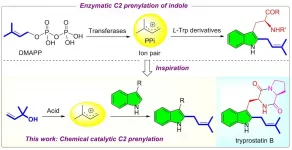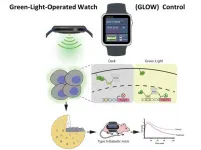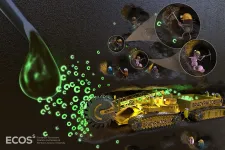Targeted COVID-19 therapy: What can we learn from autoimmune kidney diseases?
COVID-19 and the kidneys
2021-06-07
(Press-News.org) Various viruses and bacteria have long been known to cause autoimmune diseases where there is such a predisposition. This phenomenon also seems to play a major role in SARS-CoV-2, especially in severe courses. The body's own immune cells are activated, with the formation of autoantibodies that attack the body's own healthy cell structures (proteins, autoantigens); deposits of immune complexes can then trigger severe inflammatory processes and cell destruction in the body.
Some nephrological diseases are likewise of autoimmunological etiology, one example being systemic lupus erythematosus (SLE), a chronic, mostly relapsing-remitting inflammatory disease with life-threatening courses in some cases. Manifestations occur on the skin and in organs such as the lungs, heart, CNS, muscles/joints - and the kidneys. Lupus nephritis (kidney inflammation) occurs in almost three out of four cases and determines the outcomes of SLE. Many SLE patients are therefore treated or co-managed by nephrologists, with the aim of avoiding chronic kidney disease and the necessity for chronic dialysis treatment. The causes of SLE are multifactorial (e.g. genetic predisposition, hormonal and environmental triggers). In SLE, antiphospholipid antibodies (aPLs; i.e., autoantibodies against phospholipid-binding proteins) are often found, but also in other autoimmune diseases of the vascular system presenting variable clinical pictures. aPLs can interfere with the clotting system, so there is usually a tendency to thrombosis, and severe complications in pregnancy are also possible in affected women.
More and more similarities between severe COVID-19 and SLE or autoimmune diseases have meanwhile been described. An increase in autoantibody-forming lymphocytes (B cells) and their activation are also observed in critically ill COVID-19 patients, as in acute SLE relapses [2]. aPLs have also been detected in COVID-19 patients, and aPL concentrations correlated with the severity of the disease [2]. There are also some interesting clinical parallels: A pioneering study from Germany [3] shows that early kidney involvement (proteinuria, hematuria) can determine outcomes in COVID-19 patients - as is the case with SLE.
A new study on the subject has now been published by the working group led by Prof. Wolfram Ruf, Mainz, in the renowned journal Science [1]. The study showed for the first time that antiphospholipid antibodies bind to the 'EPCR LBPA' complex. This molecule complex is located at the biochemical interface of the innate immune or pathogen defense system and the clotting system. It is a lipid-protein receptor complex consisting of endosomal LBPA (lysobisphosphatidic acid from endosomes) and the EPC (endothelial protein C) receptor located on the interior surface (endothelium) of the blood vessels. In this complex, the EPC receptor presents LBPA as a pathogenic cell surface antigen. aPL binding to the EPCR-LBPA complex then activates both the endosomal inflammatory pathway and the coagulation cascade. This leads to interferon production in immune cells and to a special expansion of B cells, which then produce further autoantibodies in a self-reinforcing autoimmune signaling loop. With regard to therapy, the study also showed that, in the lupus mouse model, the specific pharmacological blockade of this EPCR-LBPA signaling inhibited severe aPL-related damage.
"Even if the pathogenic mechanism and significance of autoantibody formation in COVID-19 are not yet fully understood, it is possible that the autoimmune response, once triggered, could be the real cause of many severe COVID-19 courses", commented Prof. Dr. Julia Weinmann-Menke, Mainz, the DGfN Press Officer, at the Opening Press Conference of the ERA-EDTA Congress. She and her colleagues at the universities of Mainz, Greifswald (Prof. Dr. Jens Fielitz) and Berlin are therefore planning a cooperative clinical research project to further investigate this autoimmune disease and to find new approaches for immunological COVID-19 therapies. "Our project is based on the hypothesis that an infection-associated autoimmune response by autoantibodies is implicated in many cases of organ damage in patients with severe COVID-19," explains Prof. Weinmann-Menke. The study aims to establish a high-throughput test procedure (multiplex assay) that can be used to identify specific immune responses (immunoproteomics) to autoantigens (especially against cerebral, cardiac and renal proteins) that occur in COVID-19. Autoantibody-forming memory B cells, and the specificity of autoantibodies (tissue specificity and cross-reactivity with other organs) are to be analyzed by conducting in vitro tests. The glycosylation of autoantibodies, which is known to enhance their effect in many cases, is also to be investigated.
"Immunomodulatory therapies used or being tested in the treatment of nephrological autoimmune diseases such as SLE may also be successful in severe COVID-19 courses", concludes Prof. Weinmann-Menke. "We hope that new diagnostic options for patients will provide us with better risk assessment and more targeted therapeutic approaches, also for non-COVID-associated immune phenomena."
INFORMATION:
[1] Müller-Calleja N, Hollerbach A, Royce J et al. Lipid presentation by the protein C receptor links coagulation with autoimmunity. Science 2021 Mar 12; 371 (6534): eabc0956. doi: 10.1126/science.abc0956.
[2] Woodruff MC, Ramonell RP, Nguyen DC et al. Extrafollicular B cell responses correlate with neutralizing antibodies and morbidity in COVID-19. Nature Immunology, 2020; DOI: 10.1038/s41590-020-00814-z. https://www.nature.com/articles/s41590-020-00814-z
[3] Gross O, Moerer O, Weber M et al. COVID-19-associated nephritis: early warning for disease severity and complications? The Lancet 2020. Published: May 06, 2020DOI: https://doi.org/10.1016/S0140-6736(20)31041-2
ERA-EDTA Press Office
Dr Bettina Albers
Tel. +49 3643 7764-23/mobile +49 174 2165629
email: press@era-edta.org
ELSE PRESS RELEASES FROM THIS DATE:
2021-06-07
Terpenoids are omnipresent in almost all living organisms. Prenylated indoles are prominent representatives that usually display potent medicinal properties (e.g. tryprostatin B). Therefore, significant efforts have been devoted to indole prenylation over the past decades. The known protocols often require a multi-step procedure and rely on the use of stoichiometric promoters. From the viewpoint of step- and atom-economy, developing a direct catalytic C2 prenylation of indoles is highly desirable yet challenging, because the nucleophilicity of C2 site is weaker than that of other two positions ...
2021-06-07
Consuming large amounts of daily caffeine may increase the risk of glaucoma more than three-fold for those with a genetic predisposition to higher eye pressure according to an international, multi-center study. The research led by the Icahn School of Medicine at Mount Sinai is the first to demonstrate a dietary - genetic interaction in glaucoma. The study results published in the June print issue of Ophthalmology may suggest patients with a strong family history of glaucoma should cut down on caffeine intake.
The study is important because glaucoma is the leading cause of blindness in the United States. It looks at the impact of caffeine intake on glaucoma, ...
2021-06-07
Research Highlights:
Rates of Kawasaki disease - a condition that creates inflammation in blood vessels in the heart and is more common in children of Asian/Pacific Island descent - have substantially decreased in South Korea during the COVID-19 pandemic.
The decrease could be due to mask-wearing, hand-washing, school closures and physical distancing, suggesting Kawasaki disease may be prompted by infectious agents.
The cause of Kawasaki disease is unknown, though it may be an immune response to acute infectious illness.
DALLAS, June 7, 2021 -- The rate of Kawasaki disease in South Korea has substantially decreased during the COVID-19 pandemic, possibly due to pandemic prevention efforts, such as mask-wearing, ...
2021-06-07
CAMBRIDGE, MA -- MIT engineers have discovered a new way of generating electricity using tiny carbon particles that can create a current simply by interacting with liquid surrounding them.
The liquid, an organic solvent, draws electrons out of the particles, generating a current that could be used to drive chemical reactions or to power micro- or nanoscale robots, the researchers say.
"This mechanism is new, and this way of generating energy is completely new," says Michael Strano, the Carbon P. Dubbs Professor of Chemical Engineering at MIT. "This technology is intriguing because all you have to do is flow a solvent through a bed of these particles. ...
2021-06-07
Many modern fitness trackers and smartwatches feature integrated LEDs. The green light emitted, whether continuous or pulsed, penetrates the skin and can be used to measure the wearer's heart rate during physical activity or while at rest.
These watches have become extremely popular. A team of ETH researchers now wants to capitalise on that popularity by using the LEDs to control genes and change the behaviour of cells through the skin. The team is led by Martin Fussenegger from the Department of Biosystems Science and Engineering in Basel. He explains the challenge to this undertaking: "No naturally occurring molecular ...
2021-06-07
Levels of a protein called neurofilament light chain (NfL) in the blood can identify those who might have neurodegenerative diseases such as Down's syndrome dementia, motor neuron disease (ALS) and frontotemporal dementia, when clinical symptoms are not definitive.
Published in Nature Communications and part-funded by the NIHR Maudsley Biomedical Research Centre, the research determined a set of age-related cut-off levels of NfL which could inform its potential use in primary care settings through a simple blood test.
Joint Senior Author on the study, Dr Abdul Hye from the NIHR Maudsley Biomedical Research Centre at King's College London and South London and Maudsley NHS Foundation Trust said: 'For the first time we have shown ...
2021-06-07
The first double-blind experiment analysing the role of human decision-making in climate reconstructions has found that it can lead to substantially different results.
The experiment, designed and run by researchers from the University of Cambridge, had multiple research groups from around the world use the same raw tree-ring data to reconstruct temperature changes over the past 2,000 years.
While each of the reconstructions clearly showed that recent warming due to anthropogenic climate change is unprecedented in the past two thousand years, there were notable differences in variance, amplitude and sensitivity, ...
2021-06-07
NEW YORK, June 7, 2021--Recent studies suggest that new brain cells are being formed every day in response to injury, physical exercise, and mental stimulation. Glial cells, and in particular the ones called oligodendrocyte progenitors, are highly responsive to external signals and injuries. They can detect changes in the nervous system and form new myelin, which wraps around nerves and provides metabolic support and accurate transmission of electrical signals. As we age, however, less myelin is formed in response to external signals, and this progressive decline has been linked to the age-related cognitive and motor deficits detected in older people in the general population. Impaired ...
2021-06-07
Just a few bacterial taxa found in ecosystems across the planet are responsible for more than half of carbon cycling in soils. These new findings, made by researchers at Northern Arizona University and published in END ...
2021-06-07
In a white ocean, well above sea level, the algae thrive. Normally invisible to the naked eye, they are often spotted by hikers trekking through the mountains in late spring as strikingly coloured stretches of snow, in shades of ochre, orange and red. Known as "glacier blood", this colouring is the result of the punctual multiplication (or bloom) of the microalgae that inhabit the snow.
But apart from this impressive phenomenon, the life and organisation of mountain microalgae communities remains a secret. It is this still unknown ecosystem, now threatened by global warming, that needs to be explored. The ALPALGA* consortium aims to meet this challenge by organising and pooling research efforts on snow microalgae, and it has already received support from the Agence nationale ...
LAST 30 PRESS RELEASES:
[Press-News.org] Targeted COVID-19 therapy: What can we learn from autoimmune kidney diseases?
COVID-19 and the kidneys



